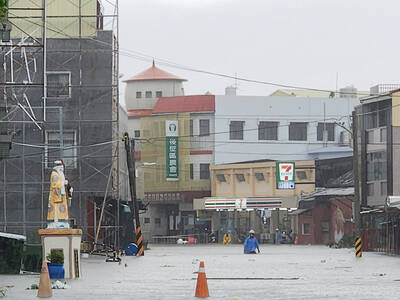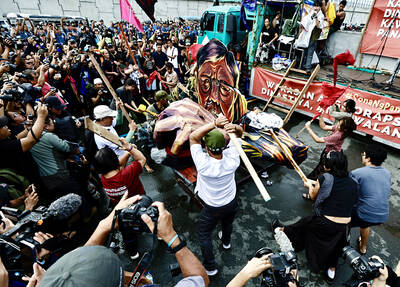India’s environment minister struck down a controversial mining project yesterday by multinational Vedanta that threatened a tribal group whose fate was compared with the stars of the film Avatar.
Jairam Ramesh rejected the proposal by British-based resource giant Vedanta, owned by Indian businessman Anil Agarwal, to build an open-cast bauxite mine in the Niyamgiri Hill range in the eastern state of Orissa.
The 8,000-strong Dongria Kondh tribespeople believe the remote hills are the home of their God, Niyam Raja, and rely on the land for their crops and livelihood.

PHOTO: AFP
Survival International, which fights for tribal groups, has run a highly successful public relations campaign likening the plight of the Dongria Kondh to the fictional Na’vi tribe in the blockbuster James Cameron film Avatar.
Ramesh told reporters that forest clearance for the project had not been granted, in keeping with a recommendation by an environment ministry advisory panel, meaning the project was “inoperable.”
“Only after being reassured by the attorney general, I have gone ahead with my decision — upholding the recommendation of the panel after due consideration,” he said.
London-listed Vedanta, the second-largest aluminum producer in India, wanted the mine in Orissa to secure a supply of bauxite for a nearby aluminum refinery.
The proposed 125 billion-rupee (US$2.7 billion) investment has emerged as a test case in India, pitting industrial development interests against those of indigenous peoples and the environment.
Vedanta argues that the mine, which has been mired in controversy since 2005, would cause minimum disturbance to the remote hills and that mined areas would be planted with trees once the bauxite was extracted.
The rejection from Ramesh appears the final nail in the coffin for the project and Vedanta has recently signaled that it is prepared to look for another site.
In a report commissioned by Ramesh and made public earlier this month, a panel of experts said the planned Vedanta project would threaten the “very survival” of the Dongria Kondh.
The report said going ahead with the open-caste mine would have a huge environmental impact that would “drastically alter” the region’s water supply, affecting both ecological systems and human communities.
It also declared that Vedanta was in “illegal occupation” of 26 hectares of land in the area at a time when the mine had yet to receive federal approval.
“This is an act of total contempt for the law on the part of the company and shows an appalling degree of collusion on the part of the concerned officials,” it said.

Rainfall is expected to become more widespread and persistent across central and southern Taiwan over the next few days, with the effects of the weather patterns becoming most prominent between last night and tomorrow, the Central Weather Administration (CWA) said yesterday. Independent meteorologist Daniel Wu (吳德榮) said that based on the latest forecast models of the combination of a low-pressure system and southwesterly winds, rainfall and flooding are expected to continue in central and southern Taiwan from today to Sunday. The CWA also warned of flash floods, thunder and lightning, and strong gusts in these areas, as well as landslides and fallen

WAITING GAME: The US has so far only offered a ‘best rate tariff,’ which officials assume is about 15 percent, the same as Japan, a person familiar with the matter said Taiwan and the US have completed “technical consultations” regarding tariffs and a finalized rate is expected to be released soon, Executive Yuan spokeswoman Michelle Lee (李慧芝) told a news conference yesterday, as a 90-day pause on US President Donald Trump’s “reciprocal” tariffs is set to expire today. The two countries have reached a “certain degree of consensus” on issues such as tariffs, nontariff trade barriers, trade facilitation, supply chain resilience and economic security, Lee said. They also discussed opportunities for cooperation, investment and procurement, she said. A joint statement is still being negotiated and would be released once the US government has made

SOUTH CHINA SEA? The Philippine president spoke of adding more classrooms and power plants, while skipping tensions with China over disputed areas Philippine President Ferdinand Marcos Jr yesterday blasted “useless and crumbling” flood control projects in a state of the nation address that focused on domestic issues after a months-long feud with his vice president. Addressing a joint session of congress after days of rain that left at least 31 dead, Marcos repeated his recent warning that the nation faced a climate change-driven “new normal,” while pledging to investigate publicly funded projects that had failed. “Let’s not pretend, the people know that these projects can breed corruption. Kickbacks ... for the boys,” he said, citing houses that were “swept away” by the floods. “Someone has

‘CRUDE’: The potential countermeasure is in response to South Africa renaming Taiwan’s representative offices and the insistence that it move out of Pretoria Taiwan is considering banning exports of semiconductors to South Africa after the latter unilaterally downgraded and changed the names of Taiwan’s two representative offices, the Ministry of Foreign Affairs (MOFA) said yesterday. On Monday last week, the South African Department of International Relations and Cooperation unilaterally released a statement saying that, as of April 1, the Taipei Liaison Offices in Pretoria and Cape Town had been renamed the “Taipei Commercial Office in Johannesburg” and the “Taipei Commercial Office in Cape Town.” Citing UN General Assembly Resolution 2758, it said that South Africa “recognizes the People’s Republic of China (PRC) as the sole